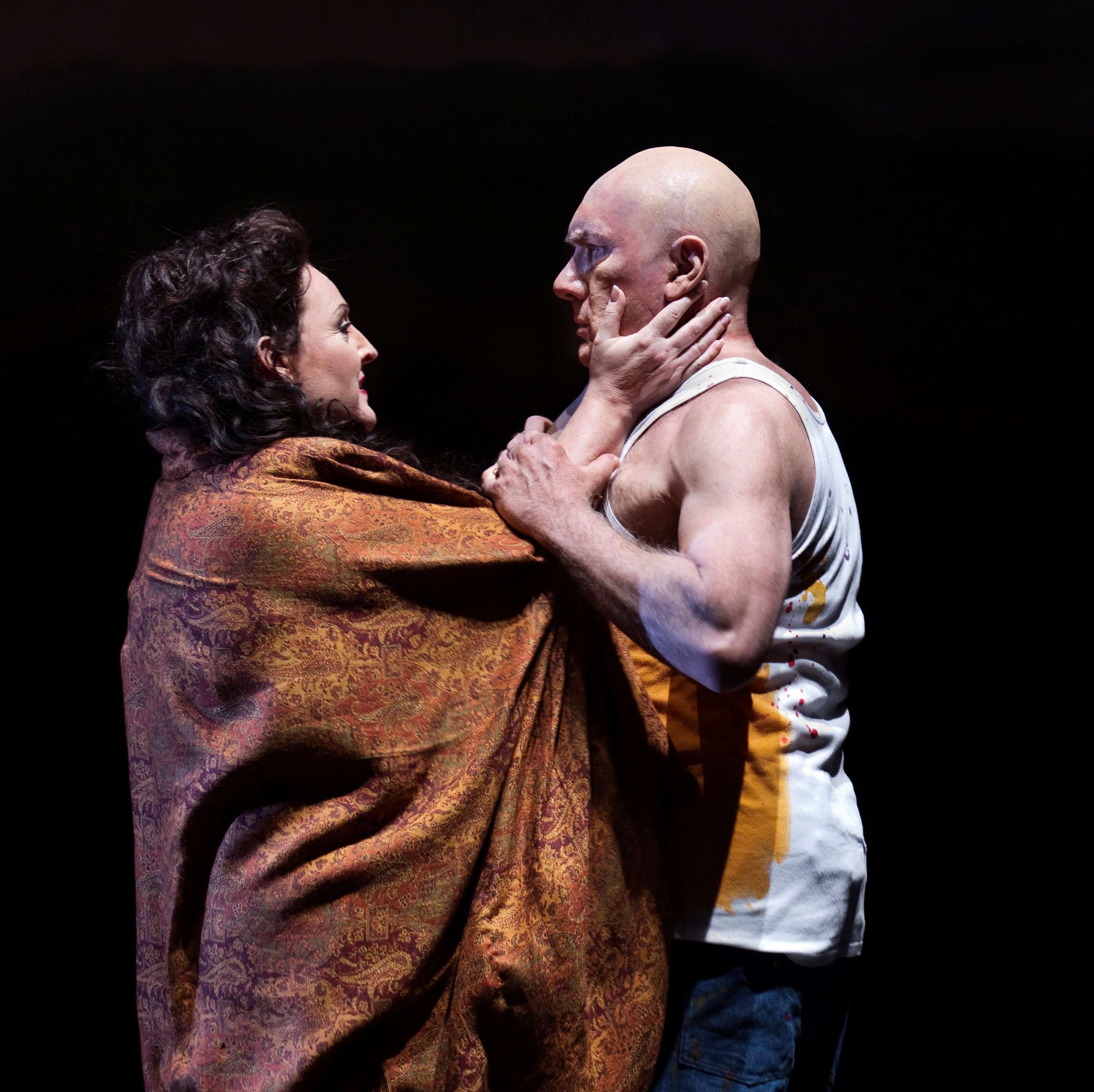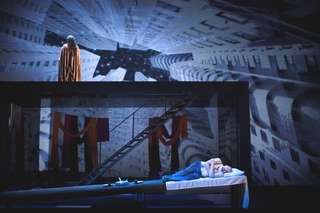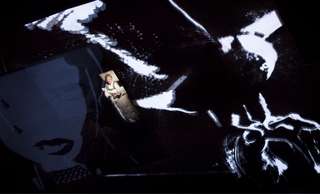|
Back
Look, Listen, and be Immersed Copenhagen
The Royal Danish Opera House, Main Stage
05/15/2011 - & May 18, 22, 28, 31, June 4, 7, 10, 14, 2011
Richard Strauss: Die Frau ohne Schatten
Johnny van Hal (The Emperor), Sylvie Valayre (The Empress), James Johnson (Barak), Linda Watson (Barak’s wife), Susanne Resmark (A Nurse), Anna Rydberg (The Guardian of the Threshold), Ludvig Lindström (The Messenger of Keikobad), Kjeld Christoffersen (The one-eyed man), Sten Byriel (The one-armed man), Peter Arnoldsson (The hunchback), Peter Lodahl (The Apparition of a Youth), Ylva Kihlberg (The Voice of a Falcon), Johanne Bock (A Voice from Above), Ole Jegindø Norup, Johan Hallsten, Stefan Cushion (Voices of the watchmen)
The Royal Danish Opera Orchestra and Chorus, Martin Nagashima Toft (chorus master), Michael Schønwandt (conductor)
Kasper Holten (director), Steffen Aarfing (set and costume designer and projections), Jesper Kongshaug (lighting designer), Steffen Aarfing and Signe Krogh (video designers), Ida Elling Magnus (dramaturge)

L. Watson, J. Johnson
(© Miklos Szabo/Courtesy of Royal Danish Opera)
With the first production of Richard Strauss’s Die Frau ohne Schatten at the Royal Danish Opera, Kaspar Holten (director) and Michael Schønwandt (conductor) overwhelmed their public in a brilliant farewell embrace that exemplifies their ten-year collaboration as (respectively) Artistic Director and Principal Conductor.
The orchestra and singers rendered a superb musical experience, and the production team entranced our vision, the most difficult sense to be satisfied in opera, with a cinematic work of art. The dramatic, minimalistic stage drops change with every scene and are overlaid and sometimes replaced by graphic video sequences that reflect the music, the action, and the emotional states of the principals.
To start with, a three-story white relief of Keikobad’s godfather-like face in sunglasses appears on a black curtain as the orchestra played Keikobad’s motif. Later, we tumble with the empress and nurse through an endless urban canyon and feel the anonymity of a sky-scraper city and its removal from nature, save for the stars above, as Barak and his wife separated for the night. A red falcon cries out and wings across the stage; a troubled empress dreams in a suspended bed; housemaids bobbing on wires tempt the dyer’s wife; children sing above a smoking pan and from the space above us; Barak and his wife embrace hesitantly as their physical world disintegrates around them, but are torn apart by violent strobe lightning to the sound of crashing music. Later, they sing their longings and regrets from suspended prison cells.

L. Watson & J. Lundgren (© Miklos Szabo/courtesy of Royal Danish Opera)
The scenography, video projections, and lighting created by Holten, Steffen Aarfing and Signe Krogh (video designers), and Jesper Kongshaug (lighting designer) allowed us to be in different worlds without the feeling that the scenes were being mechanically imposed. As the music of the intervals flowed out of the pit, the scenes changed quite naturally, symbols appeared high and low as if springing from the music into our minds, a wonderful staging for Strauss’s universe.
The Royal Danish Orchestra filled the pit, making it possible for the sound to live up to Strauss’s requirements, and musicians were also placed on the ceiling balcony far above the public. I was overwhelmed by the intensity of the eight orchestral interludes and touched by the solo vignettes, particularly the cello in the second act, but also by the woodwinds, brass, percussions, harps, and strings, all playing with formidable unity and guided by Schønwandt’s scenic timing and Mozartian energy.
Susanne Resmark (the nurse) played the role of villain in the guise of a devoted servant with great acting skill and fine control of her part from start to finish. Her top and middle ranges were perfect for the role, and her lower register solidly reiterated the threat from the deity.
Johnny van Hal (emperor), heroic tenor, sang with a strong and well-modulated voice, and his tall patrician figure was a good match to his counterpart Sylvie Valayre (empress), a slender angelic figure in a white gown and golden locks.

Sylvie Valayre (© Miklos Szabo/courtesy of Royal Danish Opera)
Valayre sang a demanding coloratura role that has a high tessitura and challenging transitions, with stamina and expression, portraying doubt, anguish, and sorrow as the empress realizes that she cannot destroy others to save her husband.
Linda Watson (Barak’s wife) played a complex woman who is struggling to forget the disappointment of infertility and to define herself under difficult circumstances. She is a powerful dramatic soprano who can sing Strauss’s and Wagner’s most demanding operatic roles. Easily heard over the orchestra, her voice has a full warm timbre that harmonizes with the orchestra’s complex tonalities. She delivered what I wanted to hear, surpassing my recollection of Birgit Nilsson’s voice in a historic recording.
James Johnson (Barak), a frequent guest soloist at the Royal Danish Opera, portrayed a good man with many responsibilities, much patience, loyalty to his brothers and wife, who nevertheless reveals a darker side when his wife rejects him and his vision of family. His natural stage presence, credibility, and fine baritone are just what the role demands.
The secondary singers and the choruses also contributed to the magic of the premiere. Ludvig Lindström (messenger of Keikobad) - handsome and celestial in an immaculate white suit - delivered an authoritative baritone with a capable bass register. Kjeld W. Christoffersen, Sten Byriel, and Peter Arnoldsson (Barak’s three brothers), competent vocalists, provided good comic relief along with the chorus of hungry waifs. Ylva Kihlberg (voice of the falcon) sang hauntingly from the ceiling balcony, and Ole Jegindø Norup, Johan Hallsten, Stefan Cushion (watchmen) ended the first act with a soothing goodnight serenade. Anna Rydberg (guardian of the threshold) sang persuasively and innocently as she, dressed in hospital whites, offered an infant to the empress, and the offstage voices of Peter Lodahl (young man, offstage tenor) and Johanne Bock (voice from above) were cast well for the roles.
The production team finessed the staging of the difficult last act with fine graphics and video projections, a shadow scene of impressive proportions, and the reunion of couples as pink dawn breaks over mountains, giving way to an image of the Sistine hands with pinkish moons slowly appearing in the sky. Against pitch black, the moons transformed into zygotes and fetuses as the yet unborn sang the opera’s last strophes.
At time when many couples have difficulty conceiving and seek out surrogate mothers, as Denmark is eliminating funding for in vitro fertilization, and the aging post-war generation is referred to as a burden (not having reared sufficient numbers of forward-thinking young adults) – it was a thought-provoking image.
Our magical adventure in Strauss’s last romantic world à la Holten and Schønwandt came to an end, and a thundering applause took its place.
Kathleen Gail Jensen
|